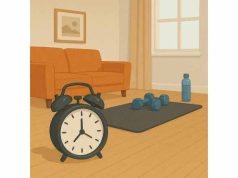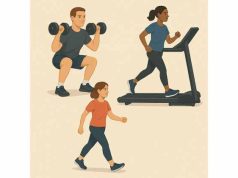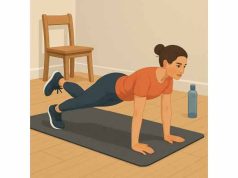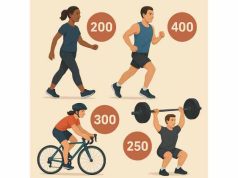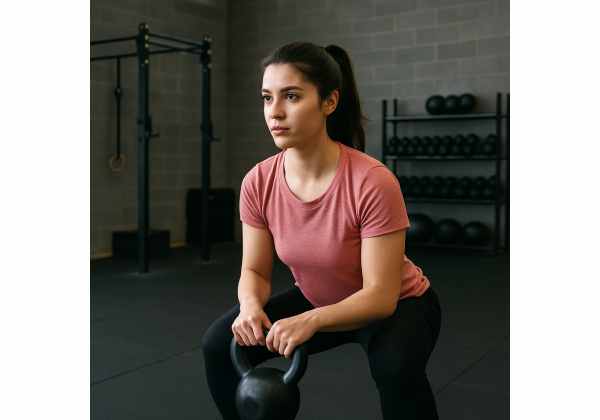
Kettlebells bridge strength and cardio in one compact tool. With the right technique and plan, you can elevate heart rate, protect muscle, and make steady progress toward fat loss—at home or in a gym. This guide gives you clear programming from first swing to intermediate complexes, so you know what to do each week and why it works. You will learn how to choose starting weights, master the hinge, and sequence workouts alongside walking and recovery. For context on how strength, cardio, and daily movement fit together during a cut, see our overview of exercise for fat loss basics.
Table of Contents
- Why kettlebells for fat loss
- Technique essentials
- Beginner program (4 weeks)
- Intermediate progression
- Fat-loss workout templates
- Programming with steps, cardio, rest
- Common mistakes and fixes
- Frequently Asked Questions
Why kettlebells for fat loss
Kettlebells are efficient because they combine multi-joint strength and sustained heart-rate work in the same session. The classic swing trains the posterior chain—glutes, hamstrings, and back—while driving a moderate to high cardiovascular demand. Presses, squats, and carries round out a balanced routine that preserves muscle while you are in a calorie deficit.
What makes them effective
- Hinge power: Swings and deadlifts load hips safely when performed with a neutral spine. Powerful hip extension raises total energy cost per minute without joint-pounding impact.
- Time economy: You can build a complete session with one bell in 20–35 minutes. Density sets (more work in less time) keep intensity high enough for conditioning while limiting total joint stress.
- Progressive overload: You can progress load (heavier bell), volume (sets or reps), or density (rest reduction). Small jumps—often 2–4 kg—make gradual progression straightforward.
- Grip and core: Every rep reinforces bracing and shoulder stability, two qualities that improve performance in other lifts and daily tasks.
- Versatility: One tool covers strength circuits, interval training, and low-impact conditioning.
Who benefits most
- Beginners who want simple patterns that scale quickly.
- Busy lifters who need efficient conditioning without sacrificing strength.
- People managing impact who prefer biking or elliptical over running, but still want robust posterior-chain training.
Expectations during a cut
- Primary goal: muscle retention, not rapid PRs.
- Two to four kettlebell sessions per week are sufficient when paired with steps and modest steady cardio.
- Appetite and recovery improve when sessions emphasize hinge quality and technique over constant red-line effort.
Equipment checklist
- One bell to start; often a second bell one size heavier within four to eight weeks.
- Flat, grippy shoes or bare feet for feedback.
- A square of open floor space and a mat for get-ups and mobility.
If you are building your plan from scratch, align your weekly volume with safe fat-loss principles first, then place kettlebell sessions accordingly. A short orientation to safe weight-loss basics will help you decide how many training and rest days to use.
Technique essentials
Solid technique keeps the work in your muscles and the stress off your joints. Before chasing speed or volume, invest in hinge mechanics, bracing, and consistent set-up. Five fundamentals matter most.
1) Hinge, do not squat the swing
Push hips back with a soft bend in the knees, shins near vertical, chest proud, and spine neutral. The bell passes high between the thighs; arms stay long and relaxed. Stand up by driving feet through the floor and snapping hips forward. The bell “floats” from hip power rather than a shoulder raise.
2) Brace and breathe
Exhale sharply at the top of the swing or during the ascent of a squat or press. Think “ribs down, abs tight.” Inhales are through the nose or a quiet mouth inhale during the backswing. A consistent brace protects your back and improves power transfer.
3) Pack the shoulders
Gently draw shoulders down and back without shrugging. This stabilizes the shoulder girdle for presses, rows, and carries. Imagine creating space between ears and shoulders.
4) Set up and park the bell
Start swings with the bell one foot in front of your toes. Hinge, grip, tip the bell toward you, hike it back, and go. Finish by guiding the bell back between the feet and parking it in front—never drop it from the top. Safe starts and landings keep form crisp as you fatigue.
5) Choose appropriate loads
Pick a bell that lets you perform crisp sets without losing posture. General starting points:
- Many beginners: 8–12 kg for single-arm work; 12–16 kg for two-hand swings and goblet squats.
- Stronger or athletic beginners: 12–16 kg single-arm; 16–20 kg two-hand swings and goblet squats.
Adjust up or down based on control, not ego.
Warm-up and mobility (5–8 minutes)
- Cat-camel x6, half-kneeling hip flexor stretch x20–30 seconds each, T-spine rotations x6 each.
- Bodyweight hip hinges x10 with pause, prying goblet squat (light bell) x5, banded shoulder external rotations x10.
A brief, targeted warm-up primes the hinge and shoulder pack without draining energy. For a deeper routine and cooldown options, see our guide to warm-up and mobility.
Quality checks during sets
- Bell path stays close; no looping away from the body.
- Hips and ribs finish stacked at the top; no overextending the low back.
- You could stop on a dime with posture intact. If not, the set is too long or the bell is too heavy.
Mastery of these basics pays dividends when you progress to cleans, presses, and complexes.
Beginner program (4 weeks)
This four-week plan builds skill, strength, and conditioning without excessive fatigue. Train three non-consecutive days per week (e.g., Mon/Wed/Fri). Each day includes a hinge, a squat, an upper-body push and pull, and a short finisher or carry. Walk 7,000–10,000 steps daily.
Session structure (30–40 minutes)
- Warm-up 5–8 minutes (see essentials).
- Skill block 6–8 minutes: swing practice or get-up practice with generous rest.
- Strength circuit 2–3 rounds, controlled tempo.
- Optional finisher 5–7 minutes: light intervals or carries.
- Cooldown 2–3 minutes easy breathing and hips.
Day A
- Hip hinge: Kettlebell deadlift 3×6–8 (pause 1 second at the floor).
- Squat: Goblet squat 3×6–8 (2-second descent, 1-second pause).
- Push: Half-kneeling one-arm press 3×6–8 each.
- Pull: One-arm row 3×8–10 each.
- Finisher (optional): Suitcase carry 3×30–45 seconds each side at moderate pace.
Day B
- Skill: Two-hand swings 6–8 sets × 10 reps, rest 45–60 seconds (stop if form fades).
- Single-leg pattern: KB hip hinge to box or staggered-stance RDL 3×6–8 each.
- Squat or lunge: Reverse lunge with goblet hold 3×6–8 each.
- Push: Elevated push-up 3×8–10.
- Finisher: 6 minutes on the minute (EMOM): 10 swings + 5–6 hardstyle planks breaths.
Day C
- Skill: Turkish get-up 3–4 singles per side (slow, crisp).
- Hinge: Swings 5×12 (or 10 if needed), rest 60–75 seconds.
- Squat: Goblet squat 3×8–10.
- Pull: Gorilla rows (alternating) 3×8–10 each.
- Finisher: Farmer carry 3×30–60 seconds.
Progression rules
- Week 1: Learn the movements, end sets with 2 reps “in reserve.”
- Week 2: Add one set to one lift each session.
- Week 3: Add 2 reps to one lift each session or shorten swing rest by 10–15 seconds.
- Week 4: Hold volume, focus on technique speed and clean reps. Optionally test one heavier set on the goblet squat and deadlift.
RPE targets
Stay around RPE 6–7 on strength work (you could do 3–4 more reps). Swings should feel powerful but controlled. Stop any set when speed drops or the bell pulls you forward.
Cardio and steps
On non-training days, walk 30–45 minutes at a conversational pace or use an easy bike ride. Keep at least one full rest day each week.
If you prefer a broader strength template you can adapt to kettlebells, our simple 3-day strength plan shows how to balance movement patterns and recovery across the week.
Intermediate progression
After four to eight weeks, you can progress by increasing load, moving to single-arm variations, or adding complexes (several lifts back-to-back without putting the bell down). Keep technique pristine and progress one variable at a time.
New movements to introduce
- Clean to rack: Efficient path from swing to front-racked position without forearm banging.
- Front squat: Heavier squat loading using the rack; strong postural demand.
- One-arm swing: Greater anti-rotation core work and grip stimulus.
- Press ladder: 1-2-3 reps per arm, repeated for several rounds.
- Complexes: For example, clean → front squat → press → swing.
Two sample progressions
- Load and density focus (two bells optional)
- Monday: A) Swings 10×10 EMOM, B) Front squat 4×5, C) Press 4×5, D) Farmer carry 3×45 seconds.
- Thursday: A) Clean and press ladder 1-2-3 × 3 rounds, B) One-arm row 3×8, C) Reverse lunge 3×8 each, D) Suitcase carry 3×40 seconds each.
Progress by adding a set to the ladder or moving to the next bell size for swings.
- Complexes and intervals focus
- Tuesday: Complex 1: 5 cleans, 5 front squats, 5 presses, 10 swings each round × 3–4 rounds, rest 2 minutes.
- Friday: Intervals: 30 seconds swings, 30 seconds rest × 12–16 sets; finish with 5 get-up singles (alternating).
Progress by adding one complex round or two interval sets, not both.
Conditioning balance
Hard complexes and swing intervals behave like HIIT. To avoid piling fatigue on your lower body, separate them from heavy squats or long hikes. If you wonder whether faster intervals or steady work suits your goals, our overview of HIIT vs steady cardio explains when each tool fits best in a fat-loss phase.
When to deload
Every 4–6 weeks, reduce sets by ~30–40%, skip intervals for one week, and keep two easy technique days. You will return fresher and often stronger.
Fat-loss workout templates
Use these plug-and-play sessions when time is tight. Choose one strength-biased session and one conditioning-biased session per week, then add steps on the other days. Warm up first.
A) 25-minute strength circuit
- Goblet squat 6–8
- One-arm press 6–8 per side
- Hip hinge (KB deadlift or RDL) 8–10
- One-arm row 8–10 per side
Run 4 rounds with 60–75 seconds rest between moves. Aim to keep form crisp rather than racing the clock.
B) 20-minute swing intervals
- 40 seconds two-hand swings
- 20 seconds rest
Repeat 10 rounds. If grip fades, switch to 20 seconds swings, 40 seconds rest for the final rounds. Cool down with a 2-minute walk and easy hip openers.
C) Press ladder and carry (densities)
- Clean and press ladder 1-2-3 per arm × 3–4 rounds (rest 60–90 seconds between rounds).
- Farmer carry 3×60 seconds, rest 60 seconds.
Keep all reps smooth; end with one set lighter than you think you could complete.
D) Complex for 15–18 minutes
Every 3 minutes: 5 cleans, 5 front squats, 5 push presses, 10 swings. Start a new round every third minute for 5–6 rounds. Rest the remainder of each 3-minute block.
E) Low-impact conditioning 30–35 minutes
- 10 swings + 20-second hardstyle plank
- 10 goblet squats
- 8 rows per side
- Easy step-ups for 1 minute
Repeat continuously at conversational pace. You should finish feeling worked but not wrung out.
Effort guidelines
- Strength circuits: RPE 6–7.
- Intervals/complexes: RPE 7–8, with the final 2–3 minutes no higher than RPE 8.
- If heart rate or breathing does not settle between sets, extend rest by 15–30 seconds.
Energy expenditure varies widely by body size, bell weight, and session structure. For context across activities, see our overview of calorie burn estimates; use them as ballpark figures rather than prescriptions.
Programming with steps, cardio, rest
Kettlebell sessions do more than enough “cardio” for many people. Pair them with daily steps and one to two easy aerobic sessions, and you have a sustainable plan that supports a calorie deficit without runaway fatigue.
Weekly skeletons
Three-day kettlebell plan (most people)
- Mon: Strength circuit (A)
- Tue: 30–45 min walk or easy bike
- Wed: Swing intervals (B) or complex (D)
- Thu: Rest + 7,000–10,000 steps
- Fri: Strength circuit (C)
- Sat: 45–60 min easy hike or walk
- Sun: Rest
Two-day kettlebell plan (busy weeks)
- Tue: Full-body strength circuit
- Fri: Intervals or complex
- Maintain 8,000–12,000 steps on at least four days.
Rest and recovery
- Keep at least two non-kettlebell days weekly. Fill them with walking and light mobility.
- Sleep 7–9 hours. Appetite, mood, and progress all track with sleep quality.
Add steady cardio if
- Your step count is low due to climate, safety, or schedule.
- You prefer to keep swing volume moderate because of grip or lower-back fatigue. Choose 30–45 minutes of easy cycling, elliptical, or brisk walking at conversational pace.
For a simple framework on how to raise movement without extra workouts, review daily walking targets in our short guide to daily steps for weight loss and adjust by 1,000–2,000 steps at a time.
Common mistakes and fixes
Even motivated lifters leave results on the table by pushing too hard or skipping basics. Use these quick fixes to keep progress steady.
Mistake 1: Muscling the swing with arms
- Fix: Think “hike, snap, float.” Relax your grip; power comes from hip extension. Practice dead-stop swings (reset each rep) for 3×5 to engrain the hinge.
Mistake 2: Too light for too long
- Fix: When sets feel snappy and posture stays solid, move up one bell size for hinge and squat patterns. Keep reps lower (5–6) for a week to adapt, then rebuild volume.
Mistake 3: Turning every session into HIIT
- Fix: Cap hard intervals or complexes at two per week. Balance with one to two strength-biased days at RPE 6–7 and easy walking on others.
Mistake 4: Neglecting the get-up
- Fix: Add 3–5 controlled singles per side weekly. It builds shoulder stability and total-body control that carries over to presses and carries.
Mistake 5: Poor rack position
- Fix: In the rack, forearm vertical, elbow near the torso, wrist straight, bell resting between forearm and biceps. If forearm bruising occurs, refine the clean path rather than accepting impact.
Mistake 6: Skipping deloads
- Fix: Every 4–6 weeks, reduce sets and remove intervals for one week. Most lifters return with better bar speed, cleaner reps, and higher adherence.
Mistake 7: Programming without steps
- Fix: Steps are low-stress, high-return movement. If fat loss stalls, increase weekly steps by 2,000–3,000 before adding more intense work.
Frequently Asked Questions
How many kettlebell workouts per week are best for fat loss?
Two to four sessions per week work well for most people. Combine one to two strength-focused days with one to two conditioning sessions, plus daily steps. Keep at least two non-kettlebell days weekly for recovery, filled with walking and light mobility.
What kettlebell weight should beginners start with?
Choose the lightest bell that allows crisp posture and a strong brace. Many beginners start with 8–12 kg for one-arm work and 12–16 kg for two-hand swings and goblet squats. Adjust based on control, not ego, and progress one size when reps stay snappy.
Are swings cardio or strength?
Both. The swing is a powerful hip-hinge that drives heart rate into a moderate to high zone without joint-pounding impact. Use short sets with quality rest for power, or intervals with fixed work and rest to emphasize conditioning.
Do I need other cardio if I train with kettlebells?
Often yes, but it can be easy. Add 30–45 minutes of steady walking or cycling one to two days per week to raise weekly energy use without excessive fatigue. Keep hard intervals or complexes to two weekly sessions.
How should I progress week to week?
Change one variable at a time. Add one set to a key lift, add two reps to a set, or shorten rest slightly. When sets stay crisp and posture solid, move to the next bell size for hinge and squat patterns, then rebuild volume.
Can kettlebell training build bulky legs?
Unlikely during a calorie deficit. Kettlebell work tends to improve muscle tone and endurance while preserving strength. Use moderate volumes, prioritize hinge mechanics, and pair training with an appropriate calorie target to support fat loss rather than mass gain.
What if swings bother my lower back?
Stop and assess technique. Many issues come from rounding the back, squatting the swing, or overextending at the top. Regress to deadlifts, practice hip-hinge drills, and keep sets short. If pain persists, consult a qualified clinician before resuming.
References
- WHO guidelines on physical activity and sedentary behaviour 2020 (Guideline)
- Enhancing Athletic Performance: A Comprehensive Review on Kettlebell Training 2024 (Systematic Review)
- The effects of kettlebell training versus resistance training using the own body mass on physical fitness and physiological adaptations in obese adults: a randomized controlled trial 2024 (RCT)
- Kettlebell swing, snatch, and bottoms-up carry: back and hip muscle activation, motion, and low back loads 2012
- Effect of High-Intensity Interval Training vs. Moderate-Intensity Continuous Training on Fat Loss and Cardiorespiratory Fitness in the Young and Middle-Aged a Systematic Review and Meta-Analysis 2023 (Systematic Review)
Medical Disclaimer
This article provides general education and is not a substitute for personalized medical advice. Consult a qualified health professional before starting or changing exercise—especially if you have cardiovascular, metabolic, or orthopedic conditions; are pregnant or postpartum; take medications that affect heart rate or blood glucose; or are returning after injury or surgery.
Share and Stay Connected
If this guide clarified how to use kettlebells for fat loss, consider sharing it with a friend and following us on your preferred social platforms. Your support helps us continue producing clear, evidence-informed resources.



